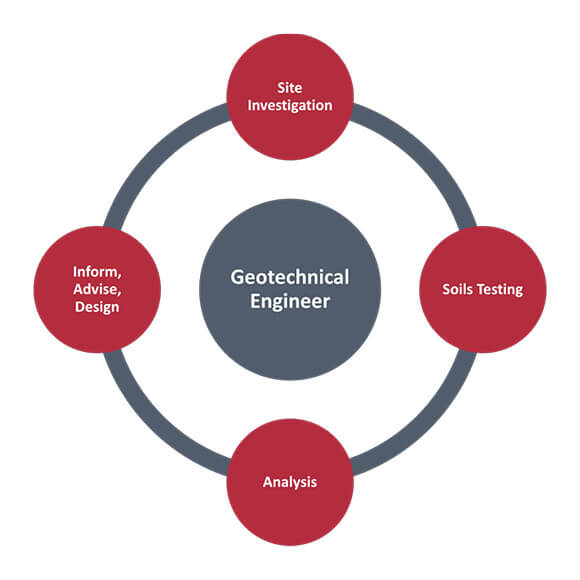The smart Trick of Geotechnical Engineering For Construction Projects That Nobody is Discussing
What Does Geotechnical Engineering For Construction Projects Do?
Table of ContentsThe Basic Principles Of Geotechnical Engineering For Construction Projects Some Of Geotechnical Engineering For Construction Projects3 Simple Techniques For Geotechnical Engineering For Construction ProjectsGeotechnical Engineering For Construction Projects - QuestionsThe Best Strategy To Use For Geotechnical Engineering For Construction ProjectsHow Geotechnical Engineering For Construction Projects can Save You Time, Stress, and Money.Geotechnical Engineering For Construction Projects for Dummies
and Kovacs, W. (1981 ), An Introduction to Geotechnical Engineering, Prentice-Hall, Inc. Deep Check Tech (2023 ): Deep Scan Technology reveals concealed structures at the site of Denmark's tallest building. "Geofrost Coring". GEOFROST. Retrieved 20 November 2020. Han, Jie (2015 ). Principles and Method of Ground Improvement. Wiley. ISBN 9781118421307. RAJU, V. R.Ground Improvement Technologies and Instance Histories. Singapore: Research Study Publishing Services. p. 809. ISBN978-981-08-3124-0. Ground Enhancement Concepts And Applications In Asia. Pariseau, William G. (2011 ). Layout analysis in rock auto mechanics. CRC Press. Hegde, A.M. and Palsule P (Geotechnical Engineering for Construction Projects).S. (2020 ), Performance of Geosynthetics Reinforced Subgrade Subjected to Repeated Car Loads: Speculative and Mathematical Studies.
Cengage Learning, Stamford, 666 p. Atkinson, J., 2007. The auto mechanics of dirts and structures. The Observational Technique in ground design principles and applications.
Geotechnical Engineering For Construction Projects Fundamentals Explained
Laboratory and field testing plays a critical role in this procedure. By drawing out examples from the planet's subsurface and applying a collection of tests, geotechnical engineers can forecast the behavior of soil layers and examine their viability for various construction efforts. The essence of geotechnical design in civil engineering can not be overstated, attributable to numerous variables: The initial step in any geotechnical research entails establishing the dirt type at the building and construction website.
Comprehending these features makes certain that only appropriate dirt kinds are picked for the development, therefore avoiding possible structural failings. The structure functions as the bedrock of any building job. Choosing the ideal structure type is a choice that rests on the detailed analysis given by geotechnical design. This makes certain the durability and stability of structures by suiting the lots they will bear.

Geotechnical website examination is a critical step in the planning and implementation of any kind of building and construction job. It involves the collection and evaluation of information connected to the physical residential properties of dirt and rock underneath a recommended building site. This details is essential for the style and building and construction of risk-free, stable, and sustainable structures.
Fascination About Geotechnical Engineering For Construction Projects
, additionally known as subsurface expedition, involves a collection of activities intended at establishing the soil, rock, and groundwater problems at a building site. The key goals are to determine potential geotechnical dangers, examine the design homes of subsurface materials, and provide referrals for the design and building and construction of structures, keeping walls, and various other structures.
The workdesk study helps in identifying potential geotechnical problems and intending the subsequent fieldwork. This involves observing the topography, drainage patterns, existing frameworks, greenery, and any signs of instability or erosion.
The smart Trick of Geotechnical Engineering For Construction Projects That Nobody is Talking About
Shallow test pits are excavated to directly observe and example the soil and rock. This technique is valuable for examining the top layers of the subsurface and identifying near-surface dangers. Non-invasive geophysical methods, such as seismic refraction, ground-penetrating radar (GPR), and electric resistivity tomography (ERT), are utilized to map subsurface problems and detect abnormalities.
Soil and rock samples gathered throughout the area examination are subjected to research laboratory visit screening to establish their physical and mechanical properties. These examinations provide important information for geotechnical analysis and style.
The primary benefit of geotechnical site examination is ensuring the safety and security of frameworks. By comprehending the subsurface problems, engineers can create structures and various other structural elements that can hold up against the tons and ecological forces they will go through. This minimizes the risk of negotiation, decrease, and architectural failure.
Geotechnical Engineering For Construction Projects Things To Know Before You Get This
For instance, comprehending dirt characteristics can assist the option of excavation methods, dewatering approaches, and ground renovation steps. This makes sure reliable and risk-free building techniques. Geotechnical website investigations are usually called for by building codes and regulations. Complying with these requirements ensures conformity with legal and safety requirements, preventing possible legal obligations and project delays.
This info is invaluable for project supervisors, engineers, and service providers in establishing realistic timetables, budgets, and backup plans. Geotechnical Engineering for Construction Projects. Skyscraper Structure in a Coastal AreaIn a seaside city, a high-rise residential structure was intended on a site with believed loosened sand down payments and a high water table. An in-depth geotechnical examination, consisting of borehole drilling, CPT, and geophysical studies, was performed
Some Known Incorrect Statements About Geotechnical Engineering For Construction Projects
Based upon these findings, the structure design was customized to consist of deep pile structures expanding into steady strata, and ground improvement methods, such as vibro-compaction, were carried out to minimize liquefaction risks. This positive method ensured the safety and security and stability of the building while avoiding pricey post-construction remediation. Infrastructure Development on a Sloping TerrainA major facilities job, involving the building of a highway and bridges, was intended on a hilly terrain with high slopes.

The Leaning Tower of Pisa (Italy), a legendary building wonder, is well known for its unexpected tilt from substantial geotechnical concerns. The tower's foundation was inadequately developed to handle the soft, unstable soil underneath it, resulting in irregular negotiation and continue reading this its unique lean. Our globe is populated with excellent infrastructure projectsfrom looming skyscrapers to stretching bridgesall standing testimony to the advancement of the various building and construction devices and approaches readily available.
Geotechnical engineering is a specialized area within civil engineering that focuses on researching the behavior of earth products. This branch delves deep right into the groundinvestigating exactly how the dirt, rock, and groundwater at a building and construction site can influenceand be influenced bythe framework that we set up on and right into them. Prior to a solitary block is laid or a concrete foundation poured, geotechnical designers probe right into the earthgathering important data concerning the site's dirt make-up, rock framework, and groundwater levels.
All about Geotechnical Engineering For Construction Projects

is a device made use of to examine the stability and load-bearing ability of stacks throughout installment, leveraging the concept of wave propagation. It enhances building and construction effectiveness by providing real-time assessments, thus making certain safe and efficient heap structures. Among the sensible applications of geotechnical engineering involves deciding and implementing the ideal approaches for foundation construction.
Load driving represents greater than the simple act of inserting structural components right into the ground. On the contrary, it is a meticulously orchestrated procedure of transferring a framework's load past the less secure soil layers better to the surfacedown to the much more considerable strata that exist underneath. When it comes to pile driving, consider exactly how geotechnical engineers skillfully use this method to equally distribute the framework's weight.